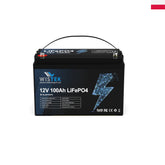Best Ways to Store Lithium Batteries Safely
Storing lithium batteries properly is essential for safety, longevity, and performance. These powerful batteries are used in everything from smartphones and laptops to electric vehicles and solar storage systems. However, improper storage of lithium batteries can lead to reduced capacity, swelling, or in rare cases, fire hazards. In this post, we’ll explore the best ways to store lithium batteries safely, whether they are for personal devices or bulk storage applications. With a proper understanding of battery chemistry and manufacturer guidelines, you can maximize lifespan and avoid the most common storage mistakes.
- Why Proper Storage of Lithium Batteries Is Important
- Ideal Environmental Conditions for Storing Lithium Batteries
- Best Containers and Storage Materials for Lithium Batteries
- How to Store Lithium Batteries for Different Use Cases
- Tips for Long-Term Storage of Lithium Batteries
- Things to Avoid When Storing Lithium Batteries
- Safe Disposal of Lithium Batteries After Storage
- Transporting Stored Lithium Batteries Safely
- Myths and Misconceptions About Storing Lithium Batteries
- Frequently Asked Questions About Storing Lithium Batteries
Why Proper Storage of Lithium Batteries Is Important
Risks of Poor Lithium Battery Storage
Improperly stored lithium batteries can suffer from capacity loss, overheating, or even internal damage. When exposed to moisture, extreme temperatures, or physical pressure, the chemical components inside lithium batteries become unstable, increasing the risk of leakage, swelling, or explosion.
Benefits of Safe Lithium Battery Storage
Safely storing lithium batteries preserves their lifespan, keeps devices functioning properly, and reduces the risk of accidents. Whether you’re keeping a few spare batteries at home or managing hundreds in a warehouse, knowing how to store lithium batteries correctly can prevent serious safety issues and financial loss.
Ideal Environmental Conditions for Storing Lithium Batteries
Temperature Ranges for Optimal Storage
The ideal storage temperature for lithium batteries is between 15°C to 25°C (59°F to 77°F). High heat accelerates chemical reactions that degrade the battery, while extreme cold can cause voltage drops and internal resistance build-up.
- Too hot (above 40°C): Risk of thermal runaway, swelling, and capacity fade.
- Too cold (below 0°C): Increases internal resistance, leading to reduced performance when reactivated.
Humidity Control
Lithium batteries should be kept in dry environments with humidity levels below 65%. Excess moisture can cause corrosion, especially on terminal contacts and protective casings. Use desiccants or dehumidifiers in storage rooms if necessary.
>>See also how many solar panels do you need to generate 15kwh
Best Containers and Storage Materials for Lithium Batteries
Fireproof Storage Bags
Specially designed LiPo safe bags are made with fire-resistant materials and can contain a fire in case a battery malfunctions. These are ideal for hobbyists or small-scale lithium battery users storing multiple cells.
Metal Boxes or Lockers
For commercial or industrial users, storing lithium batteries in metal cabinets with separate compartments for each battery helps reduce the risk of chain reactions. Use padding or dividers to prevent batteries from touching each other.
Anti-Static Containers
When storing lithium batteries for long periods, use anti-static bags or containers to protect from static electricity discharge, which can damage the battery’s internal circuitry.
How to Store Lithium Batteries for Different Use Cases
Storing Household Lithium Batteries
For phones, power banks, camera batteries, and similar small devices:
- Keep them at about 50% charge if not used regularly.
- Store them in a drawer or cabinet away from heat and direct sunlight.
- Avoid leaving them inside devices for extended periods.
Storing Lithium Batteries for Electric Vehicles and Tools
Larger lithium battery packs should be:
- Disconnected from power sources.
- Stored in a well-ventilated space.
- Monitored regularly for signs of swelling or leakage.
Always refer to the manufacturer’s storage voltage and temperature recommendations.
Storing Bulk Lithium Batteries in Warehouses
If you're responsible for a business or facility storing hundreds or thousands of lithium batteries:
- Implement FIFO (First In, First Out) rotation systems.
- Use fire-rated rooms or containers.
- Conduct regular inspections and capacity checks.
- Install temperature and smoke detectors in the storage area.
Tips for Long-Term Storage of Lithium Batteries
Charge to the Right Level Before Storing
Before storing lithium batteries for more than a few weeks, make sure they are charged to around 40% to 60%. Storing at full charge stresses the battery, while storing at zero charge can cause deep discharge and permanent capacity loss.
Check Voltage Every Few Months
For batteries in storage longer than 3 months, measure the voltage periodically. If voltage drops below safe levels (e.g., 2.5V for Li-ion), recharge to 40–60% to avoid irreversible damage.
Label and Track Storage Time
Attach labels or use digital tracking for battery batches to know how long they’ve been stored. Batteries stored too long can become unreliable or unsafe, even without visible signs.
Things to Avoid When Storing Lithium Batteries
Avoid Exposure to Direct Sunlight
Sunlight heats lithium batteries beyond safe temperatures, especially when stored in enclosed spaces like cars or sheds. Always store them away from windows or in shaded areas.
Don’t Store Near Flammable Materials
Keep lithium batteries away from gasoline, paper, cardboard, or chemicals. If a battery were to ignite, nearby flammable objects could make the situation much worse.
Never Store Swollen or Damaged Batteries
Dispose of any lithium batteries that are bulging, leaking, or have visible damage. These should never be placed in storage with healthy batteries, as they pose serious risks.
Safe Disposal of Lithium Batteries After Storage
When to Dispose
If lithium batteries have been stored for years and:
- Show visible swelling
- Fail to hold a charge
- Drop below critical voltage levels
They should be retired and replaced.
Where to Dispose of Lithium Batteries
Do not throw lithium batteries in household trash. Instead:
- Drop them off at designated battery recycling centers.
- Use manufacturer-sponsored take-back programs.
- Visit electronic stores that offer battery collection bins
Transporting Stored Lithium Batteries Safely
Preparing for Transport
If you’re moving lithium batteries from storage:
- Cover terminals with electrical tape.
- Place each battery in its own protective bag or box.
- Ensure storage containers are securely closed.
Follow Legal and Safety Guidelines
For large quantities, follow UN3480/UN3481 shipping regulations and carrier-specific rules (e.g., FedEx, UPS, DHL). Improperly packed or labeled batteries can result in shipment rejection or legal penalties.
>>See also Cost of a 15kWh Lithium Battery in the US
Myths and Misconceptions About Storing Lithium Batteries
Myth 1: Refrigerating Batteries Prolongs Life
False. Cold storage increases internal resistance and condensation risk. Lithium batteries should be stored at room temperature.
Myth 2: Fully Charging Before Storage Is Best
Incorrect. Storing lithium batteries at 100% charge can accelerate degradation. Instead, aim for 40–60%.
Myth 3: All Lithium Batteries Are the Same
Not true. Li-ion, LiFePO4, and LiPo batteries have different storage behaviors and requirements. Always check the specs for your specific battery type.
Frequently Asked Questions About Storing Lithium Batteries
How long can lithium batteries be stored?
When stored properly, lithium batteries can last 6 months to 2 years in storage without significant degradation. However, they should be checked and recharged every 3–6 months.
Is it safe to store lithium batteries in my garage?
Only if the garage is dry, temperature-controlled, and not exposed to sunlight or flammable chemicals. Avoid garages with high heat or moisture.
Can I stack lithium batteries on top of each other?
No. Batteries should be stored individually or separated with padding. Stacking can cause pressure or short circuits if the terminals are exposed.
Proper storage of lithium batteries is more than just convenience—it’s a critical aspect of battery safety and longevity. Whether you're a homeowner with spare phone batteries or a facility manager overseeing large-scale lithium battery storage, following best practices can prevent fires, extend usable life, and ensure your batteries are ready when you need them.
By maintaining stable temperatures, managing humidity, isolating batteries from flammable materials, and keeping them partially charged, you can significantly reduce risks. As lithium batteries become even more common in homes, businesses, and transportation, the need for safe storage practices becomes more essential. Understanding the best ways to store lithium batteries safely not only protects your devices and investments but also contributes to a safer environment for all.
























Leave a comment
All blog comments are checked prior to publishing